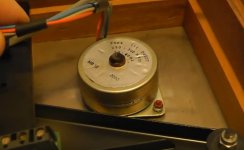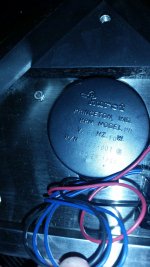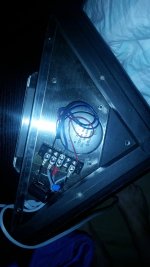Motor power for typical Turntable Motor like the 24 pole Premotec "9904 111 31813" is 1.8W. This may be the one Linn uses.
TPA3116 drives it with ease. https://www.farnell.com/datasheets/1685512.pdf
Of course you can overdimension the amp, and the transformer, by 20 times for no advantage.
The transformer is better being shielded, and/or toroidial type to minimize stray magnetic fields, with enough capability.
The L01-6362 is 24VA each, per phase and should stay nice and cool.
Get a "Killawatt" at Home Depot and measure the power draw for exact numbers.
Forsell Air Reference Hurst motor is rated for like 10W.
It is just a motor driver, you will not hear it 🙂
TPA3116 drives it with ease. https://www.farnell.com/datasheets/1685512.pdf
Of course you can overdimension the amp, and the transformer, by 20 times for no advantage.
The transformer is better being shielded, and/or toroidial type to minimize stray magnetic fields, with enough capability.
The L01-6362 is 24VA each, per phase and should stay nice and cool.
Get a "Killawatt" at Home Depot and measure the power draw for exact numbers.
Forsell Air Reference Hurst motor is rated for like 10W.
It is just a motor driver, you will not hear it 🙂
Last edited:
uptick, thanks for the link and your thoughts. After reading through the thread again and seeing the problems some were having with Class-D amps going into overload protection mode, I was trying to get folks experience with which of the 3 amps I mentioned would be the least troublesome. I have a Kill-O-Watt but my LP-12 has the Valhalla PS which would also consume some current and would not show just the motor current draw. The Valhalla is sick ( not quite dead yet) so I am building the SG4 as a better option than repairing it.
I haven't opened up the turntable yet but I do know the motor is 50 Hz, 110 V or 115 V so I can't power it directly from a wall outlet (60 Hz AC here in the US).
I haven't opened up the turntable yet but I do know the motor is 50 Hz, 110 V or 115 V so I can't power it directly from a wall outlet (60 Hz AC here in the US).
You shouldn't have a problem with any of the amps as the motor is low power and the SG4 ramps up the voltage from zero to max at start up. Previous to the ramp up, some motors would draw excessive current at start up and the amps would shut down.
You want to size the step up transformer appropriately for the motor power; the larger the xfmr, the more difficult it can be to drive. If you have a 1.8W motor, you don't need to use a 50VA xfmr, 10 or 15VA should be plenty of overhead. Also, use a xfmr with the low voltage secondary as high as possible; this will be limited by the max voltage the amp can tolerate. The reason for this is the turns ratio of the xfmr transforms the load impedance (motor) seen by the amp by a factor of the turns ratio squared. So going from a 12V secondary to a 6V secondary (turns ratio changes by 2x) increases the load seen by the amp by 4x.
When picking a secondary voltage to use, remember that the rated voltage is at full load, so a 12VAC secondary will typically produce ~15VAC with no load. This is the minimum voltage you need to apply to the secondary to get 115VAC at the primary (with no load). 15VAC is ~42VPP so it requires a 48VDC supply if using a single ended amplifier. If using a bridge amp (ie TDA7492) the output voltage is essentially doubled (but the load impedance seen by the amp is halved) so you can use a 24VDC supply to generate 15VAC.
You want to size the step up transformer appropriately for the motor power; the larger the xfmr, the more difficult it can be to drive. If you have a 1.8W motor, you don't need to use a 50VA xfmr, 10 or 15VA should be plenty of overhead. Also, use a xfmr with the low voltage secondary as high as possible; this will be limited by the max voltage the amp can tolerate. The reason for this is the turns ratio of the xfmr transforms the load impedance (motor) seen by the amp by a factor of the turns ratio squared. So going from a 12V secondary to a 6V secondary (turns ratio changes by 2x) increases the load seen by the amp by 4x.
When picking a secondary voltage to use, remember that the rated voltage is at full load, so a 12VAC secondary will typically produce ~15VAC with no load. This is the minimum voltage you need to apply to the secondary to get 115VAC at the primary (with no load). 15VAC is ~42VPP so it requires a 48VDC supply if using a single ended amplifier. If using a bridge amp (ie TDA7492) the output voltage is essentially doubled (but the load impedance seen by the amp is halved) so you can use a 24VDC supply to generate 15VAC.
You should be able to power the 115V AC 50Hz motor from the wall if the 4 motor wires has the requisite (~0.22uF)capacitor, and maybe some (100k) resistor.
A 50Hz motor runs faster at 60Hz which could be compensated with a different pulley, or a different freq, like the Valhalla (where the heroes goes to die🙂.
Looking at the schematic, the 1980's Valhalla circuit uses a 3.92MHz oscillator for 60Hz and a 3.2768MHz for 50Hz for "almost" perfect -0.303% frequency error at 60Hz, less belt-, motor-, and needle friction.
There are a few threads on Diyaudio about this power supply. High voltage semiconductors and electrolytic caps will have challenges for a long life. While these can, and should, be replaced, at least every 20 years, the speed offset and no-speed feedback makes it a dinosaur.
Back in the 80's using a transformer and a linear audio amp to drive a motor would have been a bigger deal. Today their circuit look stupid.
The LP12 is the aforementioned 1.8W Preomotek. It can be driven off the mains with a cap and resistor.
A 50Hz motor runs faster at 60Hz which could be compensated with a different pulley, or a different freq, like the Valhalla (where the heroes goes to die🙂.
Looking at the schematic, the 1980's Valhalla circuit uses a 3.92MHz oscillator for 60Hz and a 3.2768MHz for 50Hz for "almost" perfect -0.303% frequency error at 60Hz, less belt-, motor-, and needle friction.
There are a few threads on Diyaudio about this power supply. High voltage semiconductors and electrolytic caps will have challenges for a long life. While these can, and should, be replaced, at least every 20 years, the speed offset and no-speed feedback makes it a dinosaur.
Back in the 80's using a transformer and a linear audio amp to drive a motor would have been a bigger deal. Today their circuit look stupid.
The LP12 is the aforementioned 1.8W Preomotek. It can be driven off the mains with a cap and resistor.
Attachments
Thank you Bill and uptick for the information. From the datasheet, the TPA3116D2 has a max power supply voltage input of 26 V with 24 VDC recommended. At that voltage the max output voltage is 15. To supply the 12V secondaries of the AMGIS L01-6362 with 15V, it is running right at the max specs. Bill, based on your recommendation for a 10 to 15 VA transformer, AMGIS has a 9V sec. 15VA transformer, the L01-6351, with 11.1V no-load voltage. Would this be a better choice given the low power requirement of the motor? It's also a couple of bucks cheaper to boot.
Ken
Ken
Thanks for all of your help guys. I will order 2 6352s from Digi-Key and the TPA3116 amp from PE today. then I have to start building the SG4.
Ken
Ken
Is there a need to fuse the step up transformers? I'm not concerned about protecting the amplifier as it should shut down if over current, but, a shorted motor winding may damage the transformer. The transformers I am using are 25VA. I've tried a fuse in the common section of the motor neutral, and it does blow under a "short", but, when it blows one motor winding still has voltage on it via a pathway from the other motor and transformer winding.
Hello, I've assembled the sg4 and its display seems to light up appropriately. As for my next step in completing this motor controller, I am seeking some help identifying what amplifier and transformers I may need. Being fairly new to electronics assembly, I plan to get assistance at my local maker space so as to avoid injury. I've been looking for amps similar to the one Pyramid originally suggested, but I don't think any I've found in that price range have suitable heatsinks.
I'm including a couple of photographs of my VPI mk4 JR's Hurst 600 RPM 115VAC 10W motor and its wiring. I think it is a dual phase motor, but I'm not completely sure. Thanks for any assistance!
I'm including a couple of photographs of my VPI mk4 JR's Hurst 600 RPM 115VAC 10W motor and its wiring. I think it is a dual phase motor, but I'm not completely sure. Thanks for any assistance!
Attachments
https://www.amazon.com/ZXY-NAN-Ampl...&sprefix=lm3886+60+watt+board,aps,363&sr=8-38
Is the above an amp I'd been able to use? Thanks!
Is the above an amp I'd been able to use? Thanks!
If someone would let me know if they own an amp used in the original design laying around and would be willing to sell, or have a recommendation for an amp that would work for this project, it would be much appreciated. Thanks so much!
Yes it is a dual phase motor, and you could happily drive it with a stereo amplifier or modules, along with a couple of transformers to get the output voltage back up to 110v or so. Most people use class D amplifiers as they are a lot more efficient and don't need much/any heatsinking. The Hurst is a low power motor, and you would only need around 20VA transformers, and a couple of 60watt amps. Something like these should do the job
https://www.ebay.com/itm/323772896631
You need the extra power in the amps in order to manage the startup current into the transformers.
https://www.ebay.com/itm/323772896631
You need the extra power in the amps in order to manage the startup current into the transformers.
What kind of amp did I need for a 2 phase synchro motor? Did I need 2 transformers, one for each phase? My turntable is a VPI Scout. Thanks for your answers!
Yes, in order to optimise the motor using 2 active phases is best, though you can use a single phase supply, still using the phase capacitor.
Have a look at the ebay listing I referred to in the post above yours. A pair of those amps, powered by 24V 3A SMPS should do fine.
You don't say what voltage your motor runs at, but a couple of 20VA 12V -> motor voltage transformers are what you will need
Have a look at the ebay listing I referred to in the post above yours. A pair of those amps, powered by 24V 3A SMPS should do fine.
You don't say what voltage your motor runs at, but a couple of 20VA 12V -> motor voltage transformers are what you will need
Ah ok, thanks Ralph. The VPI has a 220V/50Hz motor with 4W power. 4 connections, the 2nd phase is realised via 2 capacitors which I would like to remove. Are there still programmed control units in stock? Can the phase offset be changed in the software?
Yes I still stock the SG4 chip, I also have the Pcb, with the socket for the chip already fitted. I'll send you a PM with the details.
Thank you, I would like to order chip and PCB!
Another question, is there a control unit between the sine wave generator, amplifier and transformer? Pure software? Or would it make sense to have a volume control (poti) before the amplifier?
Another question, is there a control unit between the sine wave generator, amplifier and transformer? Pure software? Or would it make sense to have a volume control (poti) before the amplifier?
This is explained earlier in the thread. Ultimately determined by the amp and transformers you use. You may need voltage divider to drop the output of the SG4 to level necessary for output from the amp. You can use a potentiometer as voltage divider.
Hi Ralph
Just ordered the PCB from Oshpark and the parts kit from Mouser.
I’d like to get 3 programmed chips from you to complete my parts list.
Please let me know costs and how to proceed.
Regards
Ian
Just ordered the PCB from Oshpark and the parts kit from Mouser.
I’d like to get 3 programmed chips from you to complete my parts list.
Please let me know costs and how to proceed.
Regards
Ian
Hi Ian,
The chips are £15 each, plus £5 for p&p
Let me know your address and I'll get them in the post to you.
Payment is by PayPal to 'ralphfcooke@yahoo.com' (don't forget the 'f' in the middle.)
Regards
Ralph
The chips are £15 each, plus £5 for p&p
Let me know your address and I'll get them in the post to you.
Payment is by PayPal to 'ralphfcooke@yahoo.com' (don't forget the 'f' in the middle.)
Regards
Ralph
- Home
- Source & Line
- Analogue Source
- 60 WPC Amplifier for DIY Turntable Motor Drive


